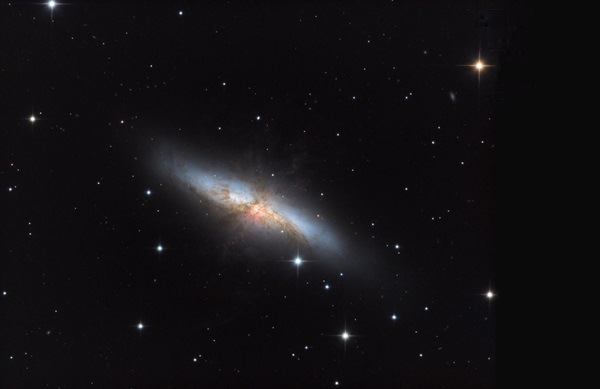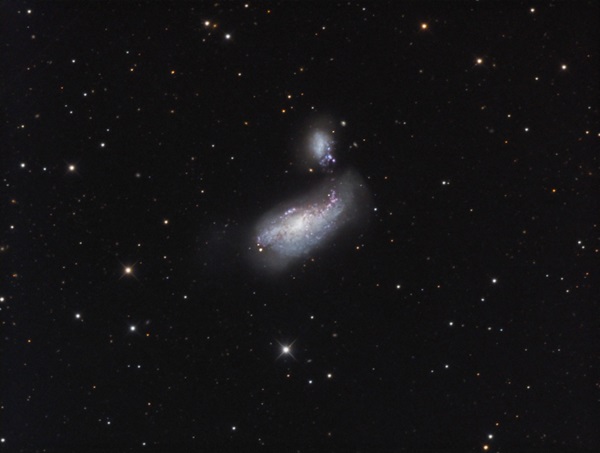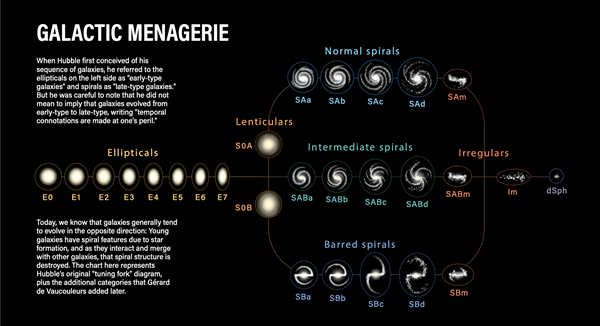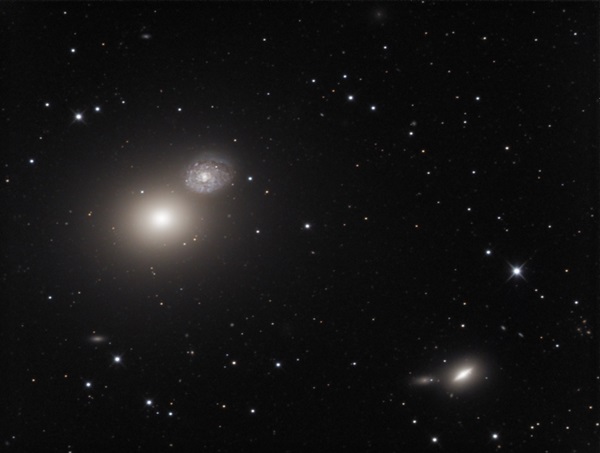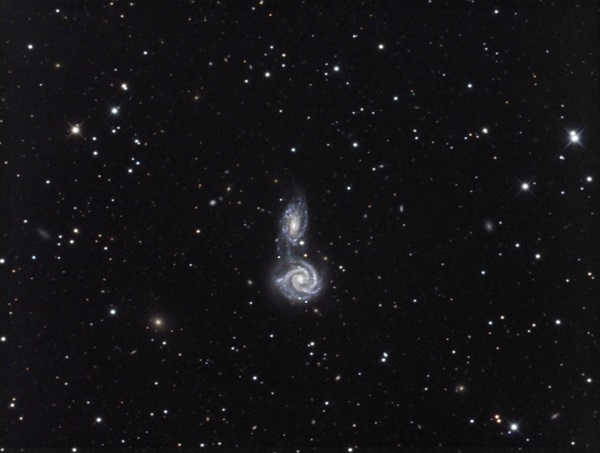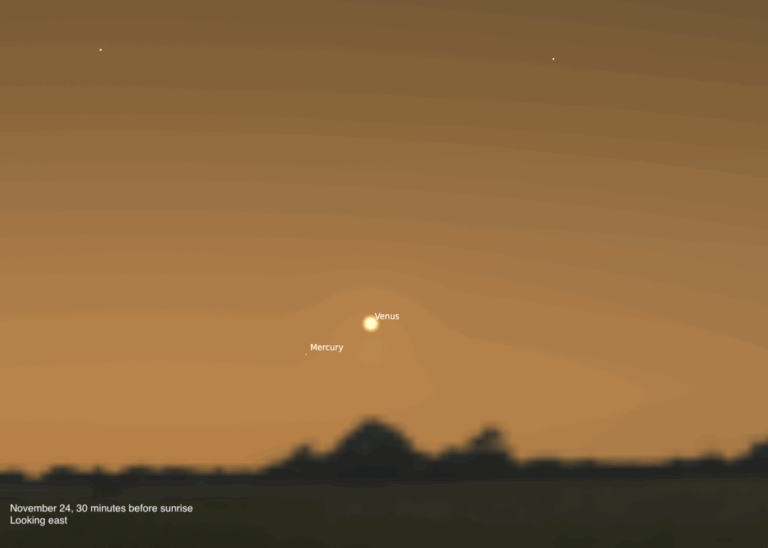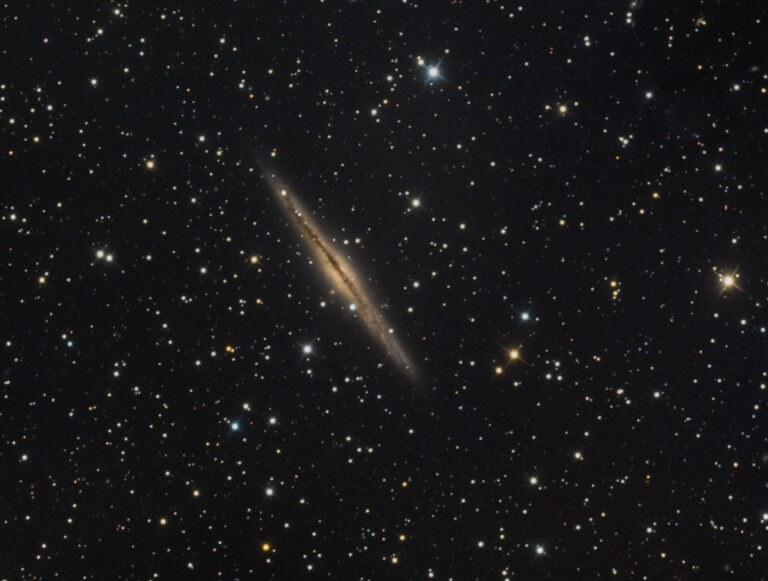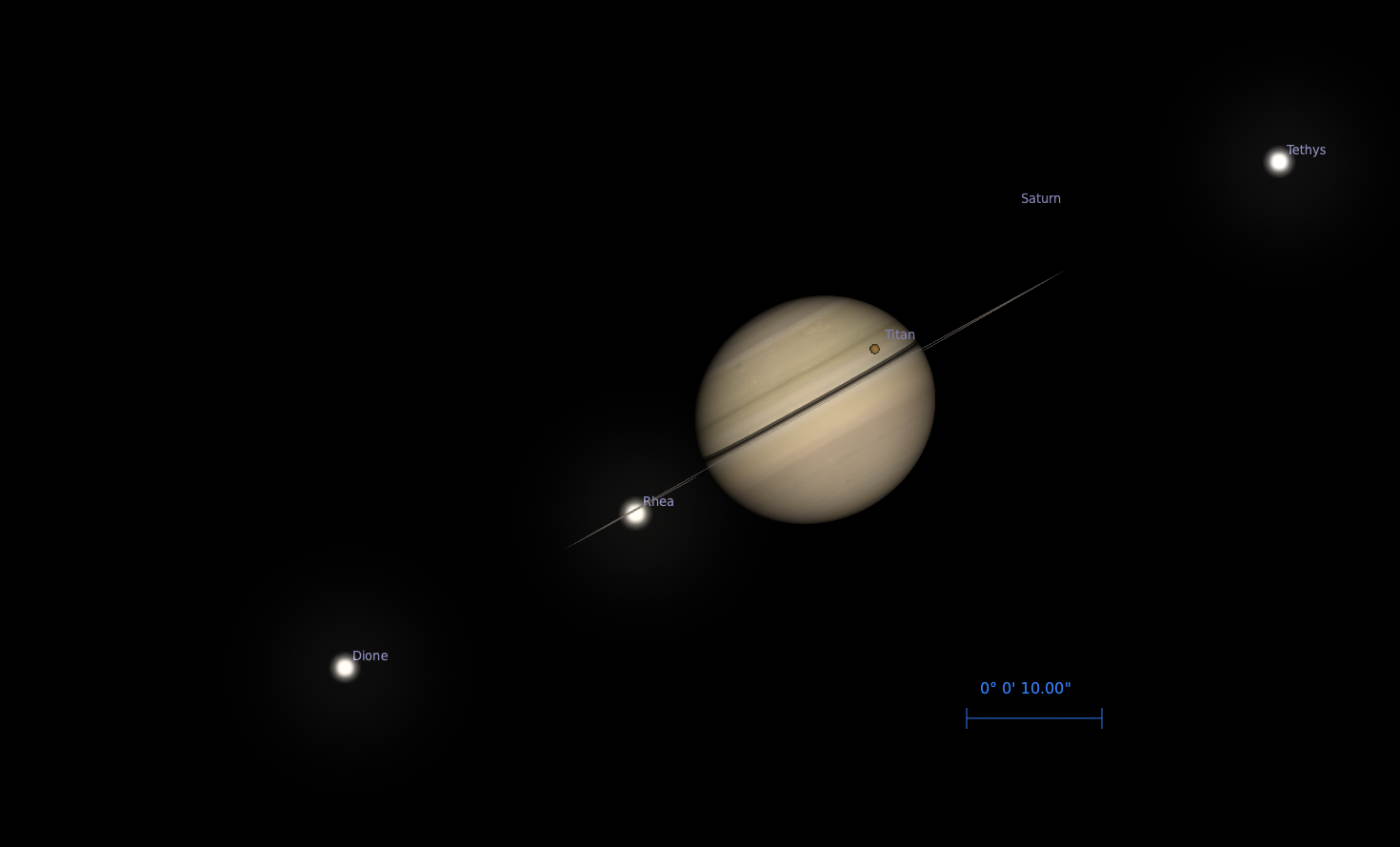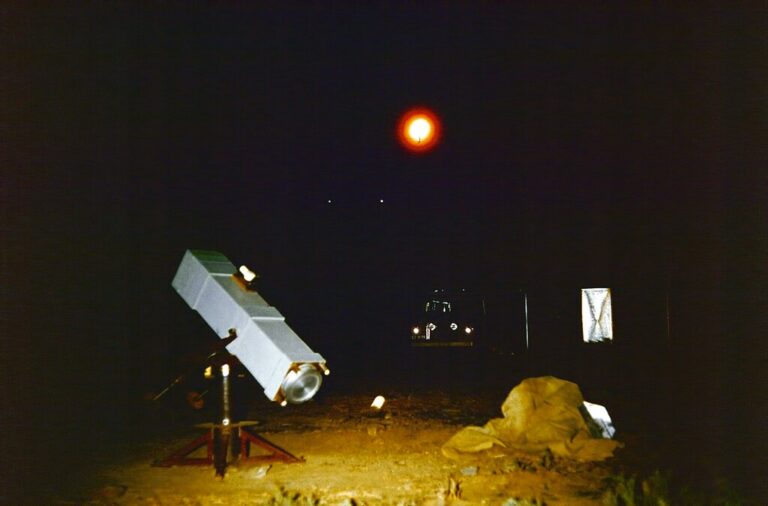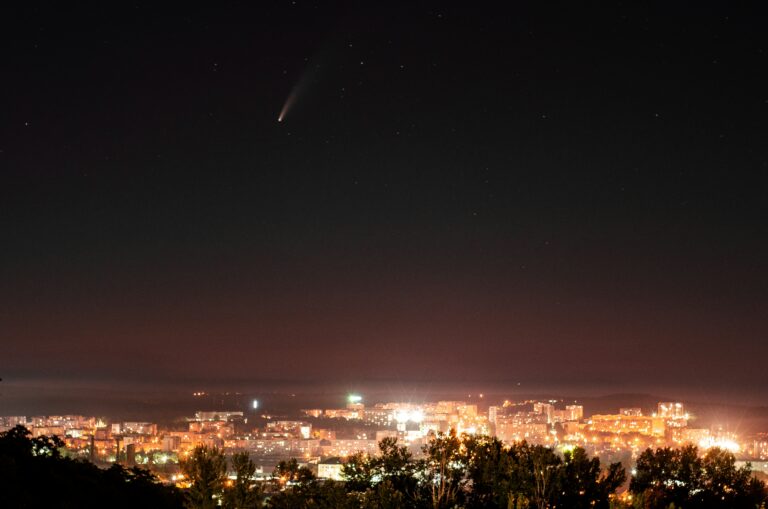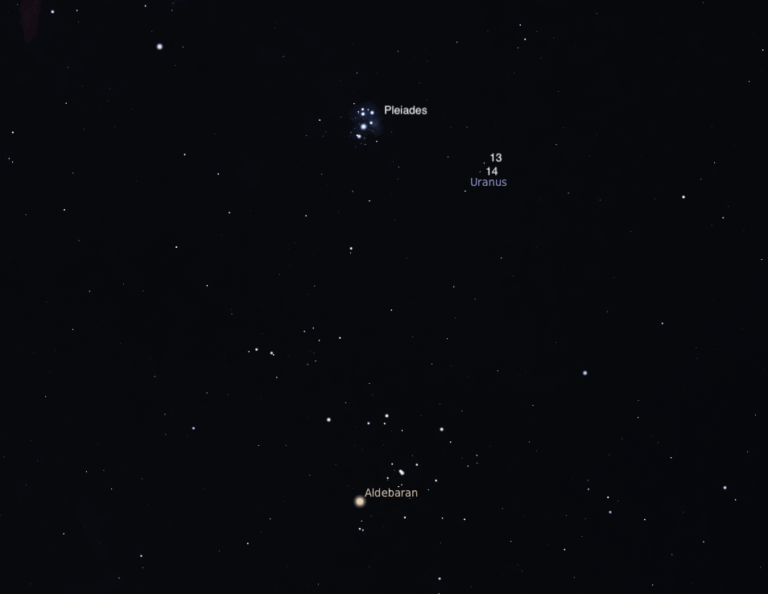Key Takeaways:
- Peculiar galaxies, exhibiting distorted shapes unlike typical spirals or ellipticals, result primarily from galactic collisions and interactions, with an estimated 5-25% of galaxies in the visible universe showing such interactions depending on infrared visibility.
- Other factors contributing to peculiar galaxy morphology include bursts of star formation, often triggered by collisions or interactions with intergalactic clouds, and active galactic nuclei fueled by supermassive black holes.
- Many peculiar galaxies are observable by amateur astronomers using 4- to 10-inch telescopes, though observing fine details requires larger apertures and dark skies. Digital imaging has greatly enhanced amateur observation capabilities in this area.
- The article lists several examples of peculiar galaxies, including interacting pairs and those with unusual features like asymmetric dark nebulae or high star formation rates, highlighting their diversity and observable characteristics.
Forty years ago, I penned my first of many articles for Astronomy. It ran in the February 1981 issue as “Observing Peculiar Galaxies.”
The term peculiar galaxies refers to a class of galaxies whose distorted shapes resemble neither classical spiral galaxies nor amorphous elliptical galaxies — and at the time, they were still mysterious. Just 16 years earlier, Halton Arp had published his Atlas of Peculiar Galaxies, a product of his documentation of objects while examining the Palomar Sky Survey. It contained a sampling of some the most unusual galaxies whose warped structures defied explanation.
After the passage of four decades, our understanding of what makes such galaxies peculiar has improved — thanks to the Hubble Space Telescope, giant new telescopes with adaptive optics, and more powerful computers that can model the gravitational dances of interacting galaxies.
Eyepiece improvements and larger telescopes have enabled the humble amateur astronomer to see details that were impossible to make out decades ago. Digital imaging technology allows amateurs to take professional-quality images that were unattainable with film. But at the same time, urban areas have seen tremendous growth, making it necessary to travel farther to get under truly dark skies. After all these changes, it’s only fair to revisit that topic with a new eye.
What makes a galaxy peculiar?
With the great diversity among “normal” galaxies, one may wonder if every galaxy has its own peculiarities. To an extent, there may be some truth to that statement. Edwin Hubble created the basis of the classification system that is used today nearly 100 years ago.
The “tuning fork diagram” contains spirals — normal and barred — in the two prongs, with ellipticals galaxies in the handle. Irregular galaxies are outside. Over time, the structure has been tweaked with two additional classifications. Lenticulars are spirals without active star formation that share characteristics with ellipticals. And we now use the term transitional barred spirals to refer to the so-called “SAB-type” in Gérard de Vaucouleurs’ galaxy classification system that he developed in the late 1950s.
Galaxies tend to occur in clusters, just like stars. But unlike stars, the sheer mass of galaxies encourages them to interact and even collide. A galaxy’s stars, dust, and hydrogen gas are all influenced by an interaction. Even a passage separated by a hundred thousand light-years provides gravitational tugs potent enough to distort galactic structure. This all happens in extreme slow motion: The passage of galaxies relative to one another takes hundreds of millions of years or longer.
As you might expect, the No. 1 cause of peculiarities is collision. An estimated 5 percent of galaxies in the visible universe are interacting. And if we had infrared vision, that number would rise to 25 percent; galaxies that emit mostly infrared light seem to interact at a higher rate. Other causes include bursts of star formation (related to collisions or interactions with intergalactic hydrogen clouds) and exploding cores (due to massive black holes). Some have anomalously large clouds of dust or glowing ionized hydrogen gas (HII regions). A small percentage are still mysterious. Given time and technology, these will become understood.
What can you see?
The good news for amateur observers is that plenty of peculiar galaxies are bright enough to be seen in 4- to 10-inch telescopes. Several can even be picked up in binoculars.
Observing detail, however, is another matter. If you have not dabbled in peculiar galaxies before, it is better to simply find these targets and not worry if you don’t see a peculiar feature.
To bring out the most detail possible, nothing beats a large aperture and dark, unpolluted skies. Another strategy to eke out shreds of detail is to avert your vision slightly to one side of the object, relying on your retina’s more light-sensitive rod cells. Perhaps they will reveal a bit of asymmetry, a faint companion, a bright patch or arm, or a shadowy dark nebula.
Some observers study a photo or two before looking at their target. Bright stars in the field may help you locate the most conspicuous aspect of the galaxy’s peculiarity. Keep in mind that photos may be reversed from what you see in the eyepiece.
I enjoy every aspect of observing peculiars, from checking off another “faint fuzzy” to seeing detail. If you don’t go in expecting to see many details, you won’t be disappointed — or, from a more optimistic perspective, you may be pleasantly surprised!
Taking up the challenge
My 1981 article featured 12 of my favorite peculiar galaxies. Since then, I’ve observed many other peculiar galaxies with larger optics. Here are 12 of my new favorites:
NGC 1228, NGC 1229, NGC 1230, and IC 1892 make up a chain of galaxies in Eridanus. These four are also known by their designation in Arp’s atlas, Arp 332. They are a faint quartet, in the 13th- to 14th-magnitude range, a challenge for a 10-inch scope. Why do galaxies line up? Perhaps it’s random chance, or maybe they evolved together in their own “local group.” NGC 1229 is a Seyfert-type galaxy — one with an active, energetic nucleus due to its central, supermassive black hole gorging on material.
NGC 2207 and IC 2163 are a pair of spirals in Canis Major. Many observers are aware of this constellation’s numerous star clusters like M41. But the Big Dog also contains a number of galaxies, including this pair in the early stages of colliding. The smaller (and more distant) of the two, IC 2163, looks comma-shaped, with arms stretched by tidal forces.
M82 (NGC 3034) in Ursa Major is a starburst galaxy, so called because it forms stars at a much greater rate than most galaxies. Called the Cigar Galaxy because it is long and narrow with rounded ends, it’s easy to see with small scopes. This Cuban is shrouded in smoky dark nebulae that can likewise be seen in small telescopes. With larger optics, the detail in the dusty shreds is fun to observe. How much detail can you see?
NGC 3226 and 3227 are nowhere close to being the brightest galaxies in Leo. But I like them because they are a “four-fer”: The bright double star Gamma (γ) Leonis lies less than a degree west of the pair (which makes them easy to find). NGC 3226 is an elliptical galaxy. NGC 3227 is a spiral. And NGC 3227 has an active nucleus. In a telescope, they appear as two oval glows with compact nuclei.
NGC 4027 in Corvus is a hook-shaped barred spiral galaxy. Its form is reminiscent of the more famous Antennae Galaxies of NGC 4038/9 (featured in the opening and closing scenes of the 1999 sci-fi comedy Galaxy Quest). The asymmetry of what I call the “Fishhook Galaxy” is due to a collision in its distant past that triggered stars to form, brightening one side. It is readily visible in moderate optics. After observing the large number of galaxies from edge-on to face-on, seeing one that is curved is a pleasant surprise.
NGC 4485 and NGC 4490 are an interacting pair in Canes Venatici that is bright enough to be seen in small optics, and close enough to show detail with more aperture. NGC 4485 was originally thought to be irregular or a weak spiral like the Large Magellanic Cloud. Its asymmetry is due to a grazing collision with the larger galaxy NGC 4490. That clash caused star formation to occur in a trail connecting the two galaxies, now separated by only 24,000 light-years. That’s only slightly closer than the Sun’s distance to the center of our galaxy.
NGC 4656 and NGC 4657, located in Canes Venatici, is a near edge-on spiral that is classified as SB(s)m, like the Large Magellanic Cloud. NGC 4657 forms the clump of HII regions and star clouds. A thin ray with a short curve at one end gives it the moniker “Hockey Stick Galaxy.” It bears magnification well. Look for it near NGC 4631 — a larger, brighter edge-on spiral — as this region of the sky is a fun area to explore with a wide-field scope.
M60 (NGC 4649) and NGC 4647, in Virgo, are an unusual duo because they have different classifications, masses, and overall luminosities. M60 is a large elliptical, appearing nearly round (between E1 and E2 in Hubble’s scheme) and visible in small instruments. NGC 4647 is a face-on intermediate spiral (SABc) with a low surface brightness. This is an example of a pair just beginning to collide.
M64 (NGC 4826) is peculiar in having a large, asymmetric dark nebula that blocks light from one half of its inner spiral disk. This feature was first noted by William Herschel in the 1780s, leading him to coin the name “Black Eye Nebula” for this galaxy. Located in Coma Berenices, M64 is a favorite for small telescope users because its “black eye” is easily observed hugging the central hub. Larger scopes will show the ragged nature of this dust cloud. Lesser known is the fact that although M64 is a type 2 Seyfert galaxy, its bright central emissions do not appear to originate from an active core, but rather from the region just around it. This may be because the core is obscured along our line of sight.
NGC 5426 and NGC 5427 in Virgo are a pair of near-twin Sc spirals in the early stages of colliding. Also cataloged as Arp 271, they are nearly perpendicular to one another. It would be interesting to see how they appear in a few hundred million years. Visually, this is a faint pair and is best viewed with 8-inch and larger optics. Knowing what you are seeing makes this a fun target.
NGC 6621 and NGC 6622 in Draco are another interacting pair that is fascinating to observe with large telescopes. Smaller scopes can distinguish the larger NGC 6621, a distorted spiral with a long arm arcing over the galaxy’s body. NGC 6622 is a compact barred spiral that has an unobscured nuclear region, while the disk of the galaxy is mostly surrounded by dust and stars from NGC 6621.
NGC 6946 is not on most lists of peculiar galaxies. This near face-on spiral on the Cepheus-Cygnus border has been nicknamed the Fireworks Galaxy because of its prodigious number of supernovae. While the Milky Way produces an average of one supernova per century, NGC 6946 produces 10 times that rate despite having only one-third as many stars. This Sc-type spiral is also thought to be a starburst galaxy. NGC 6946 is dimmed by interstellar dust from the Milky Way, but is still bright enough for small scopes in dark skies. In large scopes, it shows numerous HII regions and distinct spiral arms.
If you want to stretch the limits of your observing or imaging skills, peculiar galaxies are ideal targets. They are links to the amazing evolution of galaxies — starry halos with the heart of a black hole. Their incredible diversity of form is what makes them worth a look.

